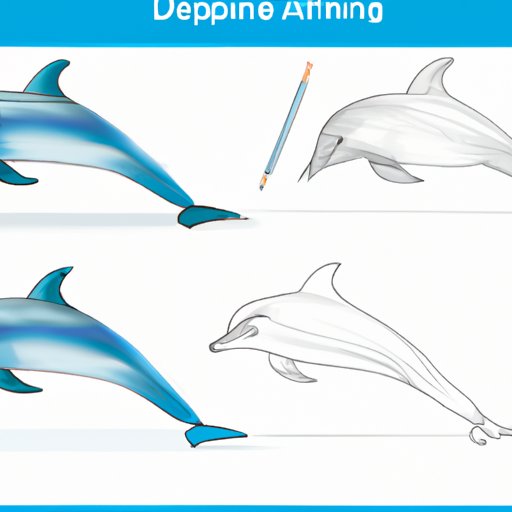
I. Introduction
Drawing dolphins can be a fun and rewarding experience for all ages. Whether you’re looking to create realistic artwork or simply adding a few doodles to your notebook, the ability to draw a dolphin is a great way to express your creativity. In this article, we will explore step-by-step tutorials, tools, and tips for beginners to learn how to draw a dolphin.
The importance of learning how to draw a dolphin extends beyond artistic pursuits. Dolphins are a popular subject for scientific textbooks, children’s books, and educational materials. Understanding their characteristics and anatomy can enhance your understanding and appreciation of these fascinating creatures.
II. Step-by-Step Tutorials Using Basic Shapes and Lines
Before we start drawing, let’s gather the necessary tools and materials. A drawing pencil, eraser, and paper are all you need to get started. You may also want to use a ruler or template to create straight lines and precise angles.
Now let’s get started with our step-by-step tutorial:
- Draw a circle for the dolphin’s head.
- Draw a small, triangle-shaped dorsal fin on top of the circle.
- Sketch two parallel lines to create the dolphin’s body.
- Add a curved line at the bottom, connecting the two parallel lines to complete the body.
- Draw a pair of curved lines on each side of the dolphin’s body to create the flippers.
- Finally, sketch a small triangle shape at the end of the body to create the tail fins.
Remember to use light sketches at first, as you’ll want to erase any mistakes before making your final lines. Once you’re happy with your drawing, darken your lines with your pencil.
Here are a few tips to make drawing your dolphin easier and more accurate:
- Start with simple shapes and lines. This will make it easier to adjust your drawing as you refine it.
- Use reference photos or illustrations to help guide your drawing.
- Focus on the overall shape and proportion of the dolphin’s body, rather than individual details.
- Practice your strokes by drawing circles, straight lines, and curved lines to develop your skills. It takes time to master any skill, so be patient and enjoy the process.
III. Video Tutorial Using Various Drawing Techniques
If you’re looking for more advanced techniques to make your dolphin drawing stand out, consider using shading and blending techniques. These techniques add depth and texture to your drawing, creating a more realistic effect. Here is a step-by-step video tutorial:
IV. Augmented/Virtual Reality Tools for a Realistic 3D Drawing Tutorial
Taking your dolphin drawing to the next level is possible with AR/VR tools. These tools provide a more interactive experience and allow you to create a 3D model of your dolphin. Here are a few AR/VR tools you can use:
- SketchAR
- Adobe Fresco
- Paint 3D
For a detailed tutorial on how to use these tools to create a realistic-looking 3D dolphin drawing, check out this video:
V. Using Dolphin’s Natural Structure and Motion for a Creative Tutorial
One of the best ways to create a unique and creative dolphin drawing is to use their natural structure and motion. Dolphins have a streamlined body and flippers that give them the ability to swim at high speeds. Here’s how you can incorporate their natural features into your drawing:
- Start by drawing the dolphin’s body in a curved motion, mimicking its natural swimming posture.
- Add the flippers on both sides of the body, using a curved shape to represent the dolphin’s movement.
- Add the fins on the back and tail, taking inspiration from their unique shape and texture.
- Use shading and blending techniques to create texture and contrast, giving your drawing a more realistic effect.
By using the dolphin’s natural features as inspiration, your drawing can stand out with a unique twist.
VI. Tips and Tricks from Professional Artists
If you’re looking for expert advice, professional artists who specialize in dolphin drawing have many tips to offer. Here are a few tips and tricks:
- Use various kinds of pencils and drawing tools to create texture and depth.
- Pay attention to proportion and perspective to create a realistic-looking drawing.
- Draw the dolphin in motion to give your drawing more life and excitement.
- Practice regularly to improve your skills and master the techniques.
- Use references like photos and illustrations to help guide your drawing.
Remember, everyone starts as a beginner, so don’t be afraid to keep practicing and experimenting until you create the perfect dolphin drawing.
VII. The History and Cultural Significance of Dolphins in Art
Dolphins have been a popular subject in art for centuries. Many famous artists throughout history have used dolphins as a symbol of love, freedom, and intelligence. For example:
- The ancient Greeks saw dolphins as a symbol of love and friendship.
- Leonardo da Vinci used dolphins as a symbol of freedom and grace in his famous painting, The Baptism of Christ.
- The Roman goddess Venus was often depicted riding a dolphin, symbolizing her association with love and beauty.
Inspired by these famous works, you can create your own dolphin drawing tutorial. Use elements of history and culture to add depth and meaning to your drawing.
VIII. Making it Easy and Fun for Beginners
If you’re just starting and want to make dolphin drawing an easy and fun process, look no further than this tutorial. Using simple doodles and sketches, this blog post provides a step-by-step process for creating your dolphin drawing:
IX. Conclusion
Drawing a dolphin requires practice, patience, and creativity. With the help of step-by-step tutorials, various tools and materials, and tips and tricks from professional artists, anyone can learn how to draw a dolphin. Regardless of your level of artistic experience, the important thing is to enjoy the process and challenge yourself to try new things.




